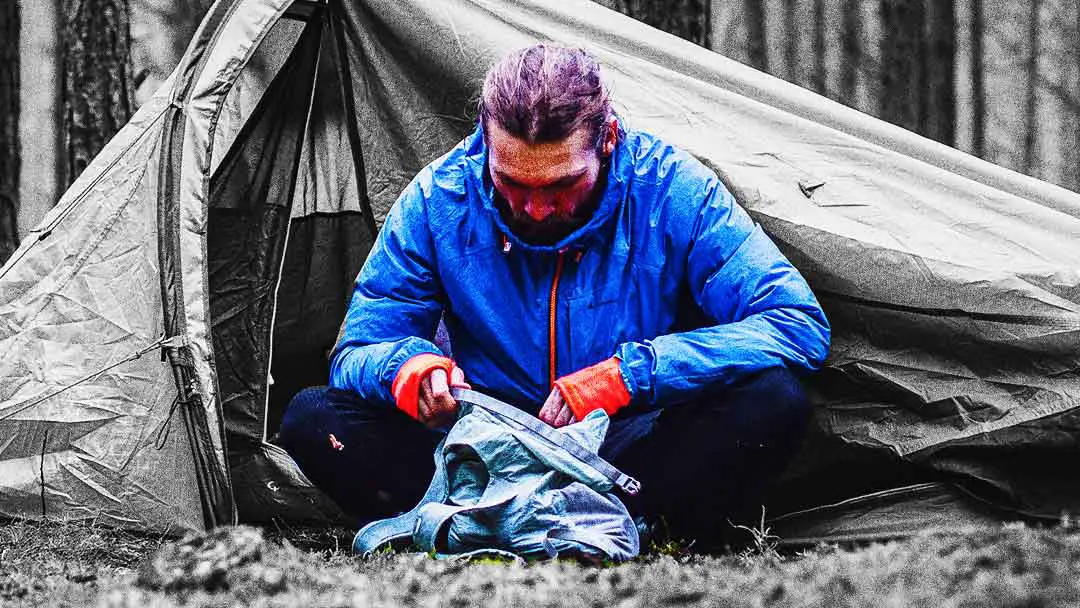8 Fastpacking Camping Tips

As an Amazon Associate we earn from qualifying purchases made on our website. If you make a purchase through links from this website, we may get a small share of the sale from Amazon and other similar affiliate programs. You can read our complete legal information for more details. By using this site, you agree the information contained here is for informational purposes only. For specific medical questions, consult your doctor. NO information on this site should be used to diagnose, treat, prevent or cure any disease or condition.
Fastpacking is terrific fun and lets you explore much greater distances than you would from traditional backpacking. One of the hardest things to get right when backpacking is the camping aspect, which is ten times harder when fastpacking.
This is because you have to go as ultralight as possible, and you may be in more remote areas than you are used to. That’s why these 8 tips are crucial to know!
Know the route
It would be best if you had a reasonable idea of how and where you will camp on a fastpacking trip.
You don’t need to know exactly where you will stay, but you should have a rough idea.
It’s important to roughly how many miles you are going to be fastpacking per dayand where that puts you in the map so that you know what terrain you will have reached.
Nothing is worse than getting towards the end of the day and losing light, but you have miles of terrain ahead of you that is unsuitable for camping.
You also need to be aware of the local rules. Are you even allowed to wild camp? Do you have to use provided campgrounds, will you have to pay, and do you need permits?

Trekking pole tent
This is an obvious choice if you go hiking or skiing with poles. Tent pole sets can weigh up to a pound, yet you can get by just fine using the poles you already have in your hands.
A simple tarp setup is your best bet if you’re trying to save a ton of money. However, modern all-season trekking pole tents can be utilized with your hiking or ski poles.
These are some high-quality fastpacking worthy tents from my top 6 list:
Since we are talking Fastpacking gear, I recommend breezing through this list to make sure you got the good stuff, The Ultimate Fastpacking Kit List.
Tarps
Tarps can be used as lightweight alternatives to tents. Where you use the tarp as a shelter from the elements, and you sleep under it in a bivvy bag to keep the bugs out and stay warm.
Or, if you are brave, you could just be in a standard sleeping bag but have a bug net on your face. It depends on where you are and what time of year.
I will be honest, though; I prefer a trekking pole tent.

Ultralight footprints
Footprints and ground cloths separate the ground from your tent’s flooring. In addition, they prevent water from seeping up through the ground and into your tent.
Use a painter’s tarp as a substitute for the expensive manufacturer’s footprint. Painter’s tarp can be found at any home improvement center.
The optimal thickness lies between 2 and 3 millimeters. Shape it to fit your tent’s footprint, and then chop off about an inch from all four sides to reduce its overall size.
While we are talking about the 8 tips for fastpacking, are you savvy with the 8 pros and cons of fastpacking?
Use rocks instead of pegs
Use the rope to attach your shelter to the nearby rocks. If you need more support, you can always make a pile. Trees and logs also work.
Pegs will add to your pack weight, surprisingly so, if you leave the mud on them from the night before.
Be careful; if you ditch the pegs and have a windy night, you might be in for a long and stressful night.
Dry your gear out
Completely covering the outside of your shelter in the morning, dew can add a few more ounces to your pack for the rest of the day.
Tents, tarps, clothing, and other gear should all be dry before being put away. You can dry them in the sun while you have breakfast or pack.
It’s not just the weight that is the problem; packing a wet tent could dampen your clothes and sleeping bag when all packed together in your fastpacking bag.
Getting wet while fastpacking can be a huge problem and a danger to your health. Speaking of which, you need to be aware of all fastpacking and camping dangers as outlined in this article: 16 Most Dangerous Fastpacking Mistakes.
Thin sleeping mat
Investing in a high-quality sleeping mat is worthwhile because it is critical to restful sleep. You could opt not to bring a mat if you really want to cut down on weight, but I prefer at least a little comfort.
¾ length self-inflating mats are an ideal alternative to standard sleeping mats because they are comfortable and fold up into a surprisingly small size when not in use.
A full-length sleeping mat is recommended in cold weather, especially in the winter when you want to keep as much body heat as possible.
A foil emergency blanket is a good idea to put under your mat for extra insulation, but it can also be used as a floor blanket to sit on during the day.

Sleeping bag
You may still get a good night’s sleep even if you’re trying to reduce your weight. An adequate amount of sleep each night is essential. The advantages of mummy sleeping bags are their compact dimensions, high warmth-to-weight ratio, and low weight.
The next step is to decide whether you prefer a down or synthetic fill. Down is more expensive and less effective in wet conditions, but it’s more comfortable overall and takes up less space in your pack.
Synthetics are often thicker and heavier than natural materials but cost less.
Choose a one or 2-season sleeping bag to minimize space if you’re going camping in mild weather.
A 1-2 season bag is sufficient even in colder temperatures if you dress in multiple layers or use a sleeping bag liner. However, a sleeping bag that provides adequate warmth is always recommended.
This is the sleeping bag I use the most: 40-degree Micron.
Oh, I almost forgot, because sleep is so important, I always bring an Ultralight Pillow that fits easily into my pack. Here are my top five I use on rotation.
Final thoughts
If you are interested in beginning fastpacking, you should really have good experience in camping.
The more experience camping you have, the easier fastpacking will be. You need to know what shelters you like, what sleeping mats you like using, what sleeping bags work best for you, and if you are comfortable sleeping outside with the sometimes crazy and scary noises you can hear in the wild.
An excellent way to get better at this is to start fastpacking but to camp in proper official campsites at night or stay in Hostels or Hotels. Then you can slowly improve your fastpacking skills but still get away on some incredible adventures.



